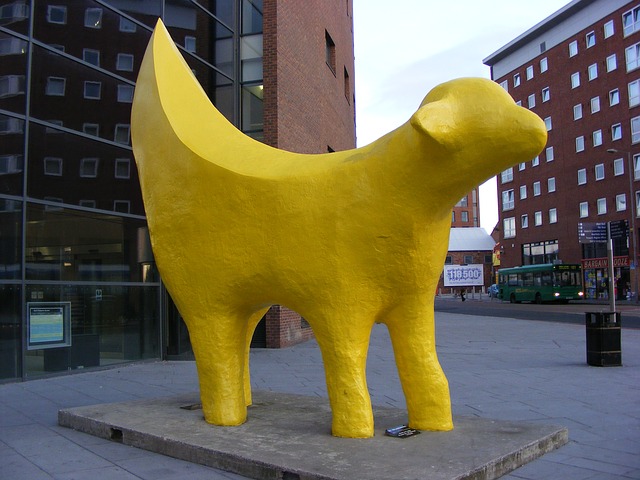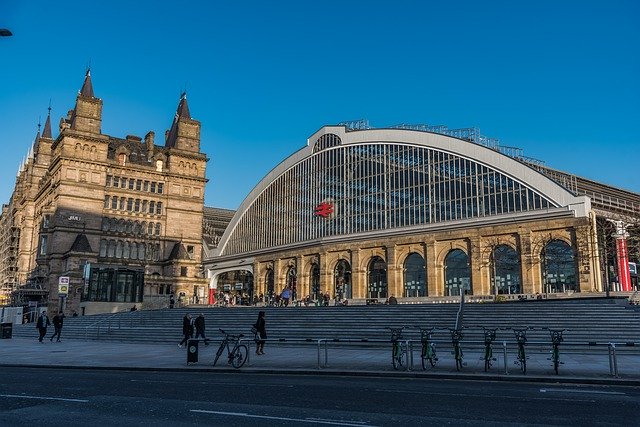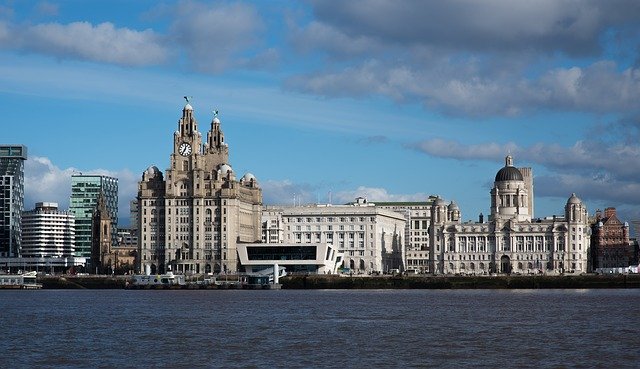Most people know that The Beatles came from Liverpool and that the city has a pretty incredible waterfront. But there’s so much more to Liverpool than that! Get to know this amazing northern city a little better with these 31 fun facts about Liverpool!
This article may contain affiliate / compensated links. For full information, please see my disclaimer here.
Contents
- 1 Fun Facts About Liverpool: History, Culture & Architecture
- 1.1 Liverpool started life as a Muddy Pool
- 1.2 There used to be a castle in Liverpool!
- 1.3 Liverpool is a World Heritage Site
- 1.4 Liverpool has the most Grade II listed buildings outside of London
- 1.5 Liverpool proves that size does matter
- 1.6 And it’s not only the clocks that are big…
- 1.7 The Liver Birds are called Bella and Bertie
- 1.8 Liverpool has the largest number of museums and galleries outside of London
- 1.9 One of the most beautiful libraries in the world is right here in Liverpool
- 1.10 1 in 10 members of the Titanic’s crew were from Merseyside
- 2 Fun Facts About Liverpool’s Fame & Fortune
- 3 Fun Facts About Liverpool’s Multicultural Roots
- 4 Quirky Facts About Liverpool
- 5 Liverpool Leads the Way
- 5.1 The RSPCA was born in Liverpool
- 5.2 The library was invented in Liverpool!
- 5.3 Liverpool was the centre for the world’s first Tropical School of Medicine
- 5.4 Liverpool built the world’s first wet dock
- 5.5 The inventor of the crossword was a Scouser
- 5.6 Liverpool Airport was the first provincial airport in the country
- 5.7 The world’s first passenger railway line ran between Liverpool and Manchester
- 5.8 Liverpool became the first English city to be awarded the European Capital of Culture
- 6 DO YOU KNOW ANY MORE INTERESTING AND FUN FACTS ABOUT LIVERPOOL?
Fun Facts About Liverpool: History, Culture & Architecture
Let’s kick off with some fun facts about Liverpool’s history, culture and architecture….
Liverpool started life as a Muddy Pool
The word Liverpool is likely taken from the medieval words ‘lifer pol’ meaning “muddy pool.”
Before King John founded the port of Liverpool in 1207, Liverpool was little more than a tidal pool and possibly a small hamlet next to the River Mersey.
Liverpool has certainly come a long way since then!
There used to be a castle in Liverpool!
Ever wondered how streets get their names? Well, there will be no prizes for guessing why Castle Street is called Castle Street!
Liverpool Castle was built in the early 13th century to protect King John’s new port.
The entrance to the gatehouse of the old Liverpool Castle is thought to have faced onto what is now known as Castle Street. The castle itself, which was surrounded by a moat, was seated at the top of what is now Lord Street – the highest point in the city overlooking the Mersey. The Queen Victoria monument can now be seen in its place.
Liverpool Castle fell into ruin and was eventually pulled down in the early 18th century. It is thought that some of the castle stone was used to build the new wet dock in the 1700s.
Liverpool is a World Heritage Site
You’ve heard of the Taj Mahal, Venice and The Great Wall of China?
Well, there’s no need to go so far away to visit a World Heritage Site as Liverpool’s waterfront was granted UNESCO in 2004!
Liverpool was defined as “the supreme example of a commercial port at the time of Britain’s greatest global influence” and was awarded World Heritage status for incredible 19th and early 20th century buildings and its pivotal role in world history.
Liverpool has the most Grade II listed buildings outside of London
With 2500 listed buildings and 250 public monuments, Liverpool has the largest number of Grade II listed buildings outside of London.
Liverpool proves that size does matter
When considering big clock faces (something I’m sure you do all the time!), most of you would probably assume that Big Ben takes the prize.
Well, you’d be wrong!
Whilst Big Ben’s clock face is pretty huge at 23 ft in diameter, the clock faces on the Liver Building measure in at a whopping 25 ft, making them the biggest in the country!
What a claim to fame!

Image by Atanas Paskalev from Pixabay
And it’s not only the clocks that are big…
Not only does Liverpool have two cathedrals, but the Anglican Cathedral takes the record for the largest cathedral in Britain AND the fifth largest cathedral in the world!
On top of that, ‘Great George’ – the Anglican Cathedral’s giant bell – weighs in at 15 tons which is a couple of tons more than Big Ben’s bell.
Anyone else starting to think Big Ben might want to consider changing its name….?

The Liver Birds are called Bella and Bertie
No one knows exactly where the names originate from, but Bella and Bertie, the two mythical Scouse birds that sit atop the Liver Building, have been a symbol of Liverpool for over 800 years.
Bella looks out to sea to keep a watchful eye over the ships arriving into port, and Bertie looks back into the city to protect the people of Liverpool.
If the 18ft copper birds – who have an impressive 24ft wingspan – ever turn to face each other, legend has it that Liverpool will cease to exist.
Liverpool has the largest number of museums and galleries outside of London
Pretty impressive, huh?
Not only that, but National Museums Liverpool (made up of the Museum of Liverpool, World Museum, International Slavery Museum, Merseyside Maritime Museum, Walker Art Gallery, Sudley House and Lady Lever Art Gallery), has the greatest number of artefacts collectively held under single ownership in the country.
And I’m not done yet!
The Museum of Liverpool – the newest of the museums in Liverpool – is the world’s first national museum dedicated to the history of a regional city. It was also the first national museum built it the UK for over a century!
One of the most beautiful libraries in the world is right here in Liverpool
The recently renovated Picton Reading Room in Liverpool’s central library is thought to be one of the most beautiful libraries in the world.
Liverpool’s Central Library is a truly spectacular building in itself with its huge domed roof (modelled on the dome in the Picton Reading Room) and its impressive balcony with views across the city. It also houses famous collections of rare books and rare archives dating as far back as the 13th century telling the story of Liverpool.
1 in 10 members of the Titanic’s crew were from Merseyside
The fateful ship was designed by the White Star Line in Albion House on James Street and about 1 in 10 members of its crew were from Merseyside.
Captain Smith (captain of the ship), Frederick Fleet (the lookout who spotted the iceberg) and Fred Clarke (the violinist who continued to play as the Titanic sank) were all from these parts.
It was the Liverpool based Cunard liner, Carpathia that rescued the 705 survivors when the ship sank on 31st May 1911.
Fun Facts About Liverpool’s Fame & Fortune
Next up: some fun facts about Liverpool’s place in the hall of fame…
Liverpool is the official ‘Capital of Pop’
Unless you live under a rock, you’ll know about Liverpool’s legendary place in musical history.
Home of The Beatles – the bestselling music artists of all time – Liverpool was awarded the title of the ‘Capital of Pop’ by the Guinness Book of Records.
More number one singles have come out of Liverpool than anywhere else in the world and Liverpool itself is mentioned in the title of more hit songs than any other city.

Image by KEVIN STEEL from Pixabay
Sir Paul McCartney autographed the Penny Lane street sign
Sir Paul McCartney himself autographed the painted sign when he stopped off there during his carpool karaoke with James Corden!
What do you mean you haven’t seen the Carpool Karaoke with Paul McCartney??
Good thing I’ve put it here for you to watch now then isn’t it?!
Liverpool is the new Hollywood
Well, not quite but it is the most filmed city outside of London.
It’s moonlighted as Venice, Dublin, Paris and Birmingham (amongst others) and has some pretty amazing acting credentials in movies such as The Fast and the Furious, Harry Potter and The 51st State, and more recently in the hit TV series Peaky Blinders.
If only we could get its autograph…
Liverpool is the best city in England at football
Home to premiership teams Liverpool FC and Everton FC, the city of Liverpool is the collective winner of a number of league championships, European Cups, UEFA Cups, a Cup Winners Cup, FA Cups, League cups and a FIFA World Cup. Wow!

Fun Facts About Liverpool’s Multicultural Roots
Moving on, here are some fun facts about Liverpool’s multicultural roots…
Liverpool’s traditional dish ‘Scouse’ actually originated in Northern Europe
Perhaps unbelievable but very true: the tasty stew known as scouse was not invented in Liverpool.
Originating from the word ‘lobscouse,’ scouse was a stew that was eaten by sailors across Northern Europe. Similar dishes are found in countries around the North Sea.
A busy seaport, lobscouse became popular in Liverpool after it was brought into the city by seafarers. Over time, the name was shortened to ‘scouse.’
So now you know…. ‘scousers’ are so-called after a tasty pot of meaty stew!
Liverpool people don’t just speak Scouse
According to statistics, more than 60 languages are spoken in Liverpool every single day!
Liverpool has a language all of its own
There are a whole host of words and phrases that are unique to Liverpool. Check out this book if you want to try and blend in with the locals.
Shanghai is Liverpool’s twin city
Liverpool has Europe’s largest and longest established Chinese community.
To mark this, Shanghai – Liverpool’s twin city – gifted Europe’s largest Imperial Arch to Liverpool.
The richly decorated Chinese Arch stands at a huge 13.5 metres tall at the entrance to Liverpool’s Chinatown.

Image by Jessica Crawford from Pixabay
Scousers are about 75% Irish
Many people fled to Liverpool from Ireland during the great famine in the mid-1800s. By 1851, more than 20% of Liverpool’s population was Irish.
Those Irish roots still run strong in the city today.
Quirky Facts About Liverpool
And here are some of the more quirky fun facts about Liverpool…
The Superlambanana is a warning against the dangers of genetic engineering
Love it or hate it, the Superlambanana is somewhat of a Liverpool icon.
The original model by Japanese artist Taro Chiezo is only 4 inches high, whilst the replica, put together by a team of four local artists, is almost 8 tonnes and 5.2 metres high.
The Superlambanana lives happily on Tithebarn Street but there are many smaller lambananas scattered around the city. A cross between a banana and a lamb, it represents a warning against the dangers of genetic engineering as well as giving a nod to the frequent cargo (bananas and sheep) of Liverpool’s historic docks.

Image by Guillaume1966 from Pixabay
Liverpool has stone megaliths older than Stonehenge
Now safely housed in the Mansion House within Calderstones Park, the Calder Stones are a group of six megaliths believed to be the remains of a Neolithic burial chamber. It is thought that around 5000+ years ago, these stones once formed the entrance to the chambered tomb. Look closely and you can see evidence of prehistoric rock art –spirals, circles and even footprints!
A network of secret tunnels run underneath the Georgian Quarter
The tunnels were the work of Joseph Williamson, a local philanthropist in the early 19th century.
It is believed by some that he commissioned the tunnels in order to create jobs for the people of Liverpool. An alternative theory suggests that Williamson was part of a religious sect that believed the world was about to end and the tunnels provided a hideaway for him and his family.
The real reason for the strange network of tunnels may never be clear.
You can actually go and visit part of the tunnels that have been excavated. Read more about it here.

There is a bewitched spring in St. James’ Cemetery
Back in 1773, Liverpool’s only natural mineral spring was discovered in St. James’ Cemetery by a group of quarrymen.
The origin of the spring remains unknown, but due to its location in one of the most notoriously haunted areas of Liverpool, there have been many a tale told about the water from the spooky spring.
If stories are to be believed, the healing properties of the cool water can relieve fevers and symptoms of diabetes.
But whatever you do, don’t boil it.
Some believe that spirits trapped inside the graveyard have contaminated the water so that it turns black when boiled.
Maybe I don’t want that cup of tea after all….
Liverpool Leads the Way
Where Liverpool leads, others follow.
These final 8 fun facts about Liverpool are a perfect example of just that!
The RSPCA was born in Liverpool
An early campaigner in the fight for animal rights, Liverpool proudly founded the RSPCA on Bold Street in 1809.
The Liverpool Branch of the RSPCA is now the longest established animal charity in the world.
The library was invented in Liverpool!
Liverpool was the first city in the world to have a subscription library service. Established in 1758 in the magnificent Grade II neo-classical Lyceum on Bold Street, it was the first lending library ever of its kind.

Image by Michal Jarmoluk from Pixabay
Liverpool was the centre for the world’s first Tropical School of Medicine
Established in 1898, the Liverpool Tropical School of Medicine was the first institution in the world dedicated to research and teaching in tropical medicine.
Liverpool built the world’s first wet dock
In 1715, Thomas Steers Dock – the world’s first wet dock – was completed, establishing Liverpool as a leader in world trade.
Later, Thomas Steers Dock – now known as the Old Dock – was replaced by larger neighbouring docks and backfilled in the 19th century.
You can still visit sections of the Old Docks hidden beneath the Liverpool One Shopping Centre. It’s a fascinating tour (and free – yay!) and I highly recommend you make the time to go!
The inventor of the crossword was a Scouser
The world’s first crossword puzzle was created by a man called Arthur Wynne, a journalist from none other than Liverpool!
Arthur Wynn published his first “word-cross” puzzle in the New York World. The name was later changed to ‘crossword’ and Sunday mornings were never quite the same again!

Image by Steve Buissinne from Pixabay
Liverpool Airport was the first provincial airport in the country
On 1st July 1933, Liverpool Airport was the first provincial airport to open in the country.
In 2001, Liverpool Airport became known as Liverpool John Lennon Airport, 21 years after the death of the former Beatles member. It became the first airport in the UK to be named after an individual.
The world’s first passenger railway line ran between Liverpool and Manchester
In 1830, the world’s first passenger railway line opened, connecting the neighbouring cities of Liverpool and Manchester.
The steam powered train was established to provide faster transportation of raw materials between the port in Liverpool and the mills of Manchester.
The railway boasts a series of world “firsts” including the first line with a timetable, the first to carry mail and the first to use a signalling system.

Image by Atanas Paskalev from Pixabay
Liverpool became the first English city to be awarded the European Capital of Culture
Liverpool celebrated its 800th birthday in 2007, and in 2008, it received a late birthday present when became the first English city to be awarded European Capital of Culture status.
Looking for some fun ways to spend time in Liverpool? Click below for my ULTIMATE guide to things to do in Liverpool!
DO YOU KNOW ANY MORE INTERESTING AND FUN FACTS ABOUT LIVERPOOL?
So there you have it! 31 interesting and fun facts about Liverpool. How many did you know?
Do you have any interesting and fun facts about Liverpool you’d like to share? Drop me a message and let me know!






Comments are closed.